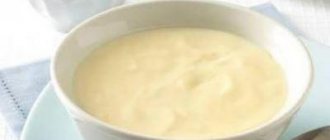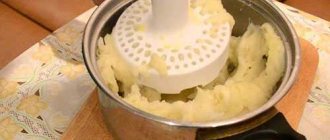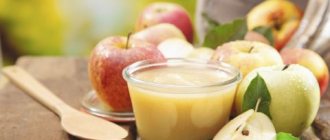There is still no consensus among mothers and doctors about what kind of porridge can and should be switched to after starting complementary feeding for infants. Among the current options is oatmeal for infants as one of the most useful and time-tested methods of complementary feeding. We all know from childhood that only porridge can provide the body with the same amount of carbohydrates, fats, microelements and vitamins as all other “adult” food.
Why oatmeal for babies?
Of course, for an infant you need to cook not ordinary rolled oats, but special baby oatmeal, which is based on the regular cereal that you and I eat. Baby oatmeal looks like flour. A typical misconception of most mothers is the belief that the powder form is easier for an infant to digest, since it is homogeneous and light. In fact, the insidious gluten protein contained in oat products can cause bloating and discomfort in the stomach, so if your child’s body has not established a stable digestive process, then you should avoid porridge.
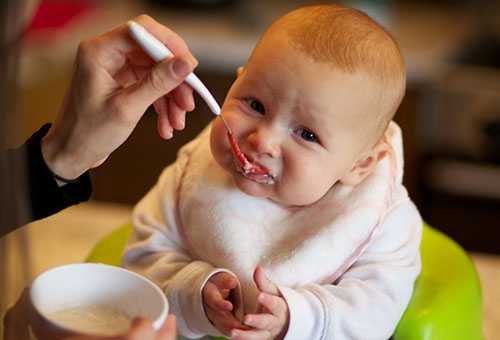
Oatmeal for a child: when to give and how much. How to cook oatmeal for children, recipe
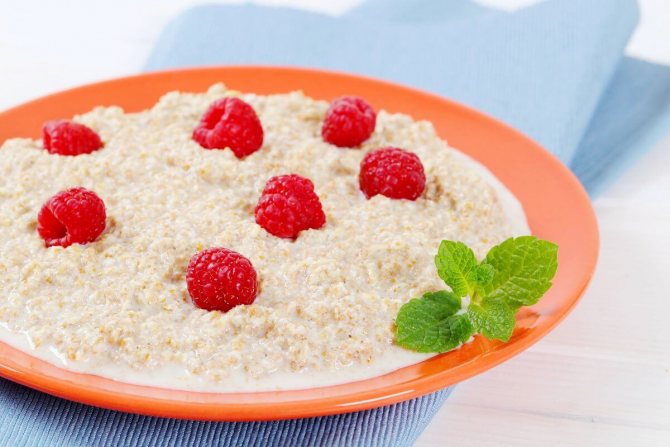
- What are the benefits of oatmeal for children?
- Oatmeal for children: at what age should it be introduced into complementary foods?
- How to cook oatmeal for a child
- General recommendations
- How much oatmeal should I give my child?
- Oatmeal with milk for baby, recipe
- Oatmeal for children, recipe step by step
Hercules and other types of oatmeal are considered much healthier than other cereals. After all, this culture contains a lot of microelements, vitamins and is easily digested. Therefore, most parents try to introduce oat porridge into complementary foods as early as possible. But pediatricians advise to be more careful. After all, this porridge, like other products, has its contraindications, and its abuse can lead to damage to the baby’s health.
Hercules and other types of oatmeal are considered much healthier than other cereals. After all, this culture contains a lot of microelements, vitamins and is easily digested. Therefore, most parents try to introduce oat porridge into complementary foods as early as possible. But pediatricians advise to be more careful. After all, this porridge, like other products, has its contraindications, and its abuse can lead to damage to the baby’s health.
When can you give oatmeal?
Many young mothers are concerned about the question of at what age it is appropriate to start cooking porridge, because it is impossible to determine by eye whether the baby’s body is ready for such changes or not yet. Here children's doctors unanimously declare - 5 months. It is from this age that the child’s stomach can switch to something more substantial than milk.
If you are still in doubt whether to cook porridge or not, then a more specific way to determine the child’s readiness for complementary feeding is the most superficial stool analysis. If the infant eats well and does not suffer from constipation or allergic reactions, then you can start cooking oat porridge for him. If, on the contrary, the baby has difficulties with the digestive process, constantly cries due to constipation and is susceptible to allergies, then it is better to postpone oatmeal until better times. The fact is that oatmeal contains gluten, a type of protein that causes allergies. You should not expose your baby to such danger, even if it seems to you that he is already big enough.
Helpful: What foods are acceptable on the menu for an 8 month old baby?
Another signal that your child is ready for more serious food is his immediate eating behavior. If the feeding process begins to take less time than before, and the child asks for food more and more often, it means that his stomach has grown. It is at this moment that you should start complementary feeding. Just introduce oatmeal into the menu gradually, cook it in small portions so that the child does not feel any changes.
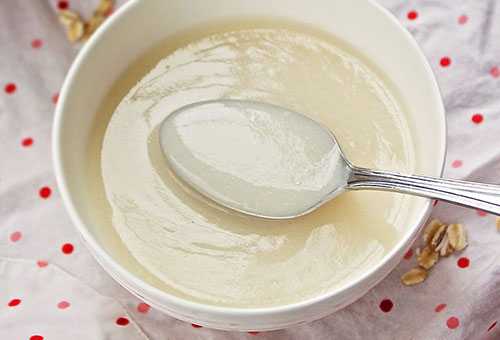
What are the contraindications for oatmeal?
Despite the many beneficial properties, you need to start cereal complementary foods with buckwheat, corn and rice cereals. Unlike oatmeal, they do not contain gluten, which can cause allergies. Since the baby's digestive system is not yet fully formed, gluten protein can lead to colic, upset stool and other tummy problems. Oatmeal can be offered to babies from 7-8 months. Introduce the product starting with a small portion. Watch your baby's reaction carefully. By the age of one year, a portion of porridge can be 150-200 grams.
In some cases, children develop complete gluten intolerance. This disease is called celiac disease. It can be recognized by such signs as whims, copious loose stools with the presence of mucus. In this case, oatmeal is contraindicated. Luckily, there are many gluten-free grain products available.
Even the healthiest foods are good in moderation. Phytic acid contained in oats, when consumed in excess, leads to calcium leaching and interferes with its absorption. And a large amount of fiber can cause flatulence. Therefore, there is no need to include oatmeal in your daily menu. Twice a week will be enough to get optimal benefits from the product.
How to cook oatmeal for babies?
Preparing oatmeal for an infant today is not particularly difficult for the reason that stores offer a huge assortment of instant porridges, ready-made porridges, and so on. This is where sensible mothers immediately have a question: what is better - to cook porridge yourself or buy it in a store? Since sometimes the manufacturer himself cannot vouch for the composition of instant porridge, it is obvious that it is better to set aside time to prepare the porridge yourself.
The oatmeal recipe is quite simple. To prepare oatmeal, you must first rinse the cereal and dry it. Oatmeal is prepared using a coffee grinder or blender. The finished flour is boiled in water, breast milk or vegetable broth.
Oatmeal for babies must follow a strict recipe:
- grind a teaspoon of flour;
- heat 100 ml of liquid (about half a glass) to a boil;
- Add flour to the liquid and cook over low heat.
Attention!
Using a microwave oven is not recommended!

If your child has an allergy, stop eating oatmeal for a while.
How to cook a delicious dish
Oatmeal as a first complementary food should be cooked without sugar and salt. Only after the baby gets used to the dish and he does not have allergies can these components be introduced.
Before cooking, sort the grains, rinse until clear water appears and dry. For convenience, you can take a lot of oatmeal so that you don’t have to do a similar procedure every time before cooking.
Oatmeal is prepared in a ratio of 1:2. For the first few times, it is enough to take a teaspoon per 100 ml of water.
It is better to choose a metal pan with a thick bottom so that the porridge does not stick or burn. You can use a slow cooker.
It is better to cook complementary foods in the form of porridge for an infant using water, vegetable broth, breast milk or special baby milk.
1 Recipe for porridge made from ground flakes with water or milk
Grind the required amount of rolled oats and add to heated milk or water. Cook the porridge over low heat, stirring constantly. The cooking time after boiling is 5 minutes.
2 Recipe for whole grain porridge with water and milk
Pour a glass of water into a saucepan and put on fire. When the water boils, add the cereal. Cook for 20 minutes over low heat. After this, the resulting mass is passed through a sieve. At the same time, heat the milk. The finished mashed porridge is diluted with milk and brought to a boil again.
3 Recipe for oatmeal porridge with milk or water
The product is poured with boiled water and left for some time. At this moment, milk is boiled in a saucepan. Place oatmeal into boiling liquid and cook for 3 minutes.
4 Recipe for oatmeal decoction with milk
Boil water and add flakes. Cook for 30 minutes. Pour in the milk and cook for another 5 minutes. The broth is infused for an hour. Strain through a sieve.
The decoction helps cope with constipation and weight loss. It can be added to bathing water as it softens the skin, relieves inflammation and irritation. You should not give the decoction to your child often, as it can cause diarrhea, colic, and abdominal pain.
When offering a baby any dish as a first complementary food, you need to weigh the pros and cons. The benefits of oatmeal are great, the main thing is to know when to stop and be careful.
Basic rules and recommendations
- If a child is sick or in the process of recovery, then it is better to wait to change the diet, since any change in the usual menu is always acutely perceived by the delicate body. You will always have time to cook the porridge, so it is better to be patient for two to three weeks until the baby’s condition returns to normal.
- At the very first feeding, let your baby choose his own menu. A common mistake many young mothers make is trying to suddenly switch to a new type of diet and shove a spoon of porridge into the poor child’s mouth with all their might. If your child, after trying the porridge, turns away from the spoon, do not try to put pressure on him. Instead, try making porridge with breast milk next time to get a more familiar taste. In fact, this advice is more psychological than practical: when you let your child choose something for himself, even from such an early age, you instill in him independence, the ability to make decisions and take responsibility for his choices.
- Feeding should be done in tiny portions; there is no need to cook a whole pan for the first time. In the fifth month of life, the baby can only eat one teaspoon of porridge!
- Of course, you cannot replace breastfeeding with porridge immediately and irrevocably, and you won’t succeed, since the baby will constantly ask for the breast. It is suggested that one serving of breast milk is replaced with a spoonful of oatmeal according to the recipe above.
Useful: How to properly attach a baby to the breast
Before starting complementary feeding, it is, of course, better to consult with your pediatrician. The most correct decision is to follow the action plan that your attending physician, who is already familiar with the developmental features of the infant’s body, has developed for you and your child.
Oatmeal for babies: age restrictions, recipes and medical indications
- Composition and properties
- When to introduce complementary foods?
- How to choose cereal?
- How to cook?
- Doctors' recommendations
As you know, when it’s time to transfer a baby from mother’s milk to other foods, complementary feeding most often begins with a variety of cereals. This choice is made quite reasonably, because this dish is full of useful elements and is almost completely harmless. Oatmeal is very popular.
All these components are responsible for the harmonious development of the child’s body.
Regular consumption has a beneficial effect on metabolism and brain activity and improves the functioning of the renal system and liver. In addition, toxins and waste leave the body, the immune system is strengthened, and the digestive system copes with new foods without problems thanks to the available fiber.
Recommended timing of product introduction
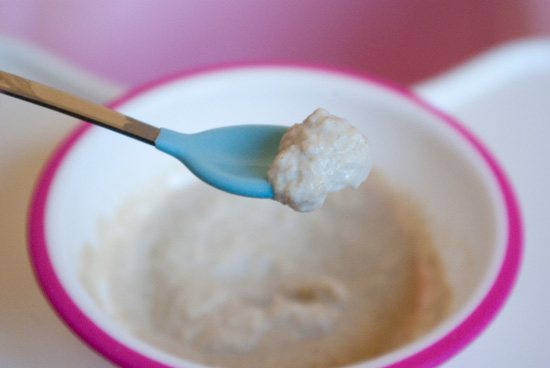
Your pediatrician will recommend introducing oats as complementary foods to your baby, based on various factors. The recommended period for children under one year old who are breastfed is after 8 months. Artificial babies can be introduced to oatmeal a little earlier, after 6 months.
A possible gluten allergy is an important factor that should not be forgotten. Start complementary feeding with gluten-free cereals: buckwheat, rice, corn.
Oatmeal should be administered extremely carefully, dosing the proposed volume and monitoring the general condition of the digestive system of a child in the first year of life in order to exclude intolerance to the product. We advise you to keep a food diary. This way, at the first sign of an allergy, you will immediately know which product caused it.
Whatever recipe you like, when cooking for a baby under one year old, you should adhere to the basic principles of preparing the first complementary foods.
How to cook oatmeal for babies
Oatmeal is ground into powder. The optimal proportion for feeding a baby is considered to be five percent porridge. Place 5 g of the resulting powder in a teaspoon. It is diluted with 100 ml. water. If the volume is needed large, the proportion is doubled. When the child grows up, you can increase the oat intake to 10 g per 100 ml. water.
Oatmeal porridge



